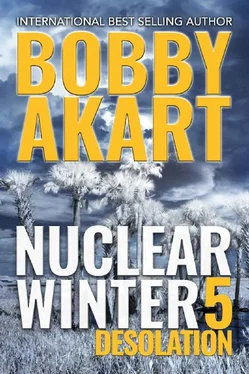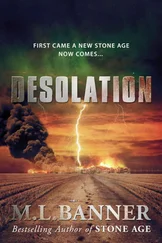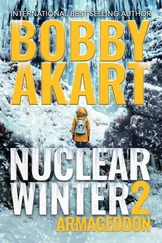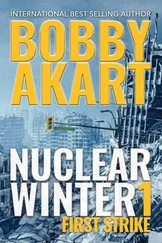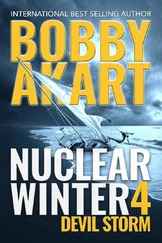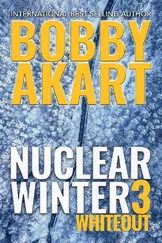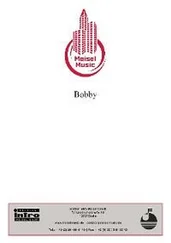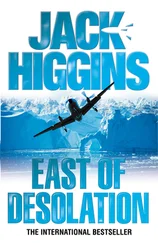The president had intended that morning’s briefing to be a strategic planning session. He wanted to establish some form of timeline for the recovery. To the best of his ability, he wanted to disseminate to the media and the American people what to expect as they moved forward. By the time the scientists were finished, he’d wanted to bolt out of the room and find a stiff drink, regardless of the early hour.
The briefing was coming to a close when the FEMA director announced their findings on the death toll estimates. It had been twenty-five days since the Iranians had fired the first nuclear missile at Israel. Their actions had triggered the nuclear war that went on for days, culminating with the attacks on the United States on day seven.
By that time, the climatic effect of nuclear winter had already reached America’s shores. The detonations on the East and West Coast only accelerated the disaster. However, it was the EMP effect of the nuclear detonations coupled with the subsequent overload of the nation’s Eastern and Western Interconnection, the power grid, that exacerbated the catastrophe.
The onset of nuclear winter was a long-term problem that was expected to last a decade. Its impact on sources of water was unseen, but profound. Lakes, rivers, and underground aquifers, fed by rain and melting snow, were the source of the country’s water supply. The fallout from the nuclear detonations and the soot generated by the wildfires polluted these natural resources.
With the loss of electricity across most of the country, the nation’s critical infrastructure could no longer function. Without power, water treatment plants that employed mechanical processes to filter and purify water so it was safe for human consumption couldn’t operate. For existing stored water in large, enclosed reservoirs, the distribution system of pipes and pumps was unable to deliver the clean water to end-users’ taps. Neither wastewater nor stormwater could be collected or treated, as sewer systems required electricity to operate.
The human body could only survive three days without water before it began to dehydrate. At first, the effects of dehydration were evident by common symptoms like headache, dizziness, change in urination, and dry mouth. However, after those three days, the complications of untreated dehydration became more profound, and the onset of the problems came rapidly. The body’s vital organs simply shut down. Seizures and involuntary muscle contractions overcame the person. As the kidneys shut down, other organs like the heart were profoundly affected as low blood volume caused a rapid drop in blood pressure and oxygen. As the dehydration victim went into hypovolemic shock, death came quickly, and it was brutal.
All around the nation, people suffering from dehydration began to search for anything to rehydrate their bodies. They turned to the natural sources of water that formed the basis for the nation’s water supply. However, these lakes, streams, and rivers were polluted by the fallout from nuclear winter. They were beset with dysentery that only hastened the dehydration process.
By day twenty-five, there wasn’t a grocery store or a food-storage warehouse in America that hadn’t been looted or emptied. Desperate people trying to feed themselves or their loved ones stormed facilities, even those protected by armed guards, in an effort to grab a case of green beans or a container of baby formula.
Neighbor approached neighbor in search of help. If a family had a little extra and they gave it to their neighbor, they’d find themselves answering the door again the next day as the neighbor returned for more. If a family refused the neighbor’s pleas, the day after that, he might arrive at the door with a gun. A new father whose wife and newborn child were at home dying of starvation was willing to do anything to help them, including killing his best friend he’d once grilled and shared beers with.
During that morning briefing, the president was given a reality check. He’d been a politician for most of his adult life, insulated from the realities of daily life. His memory of living under the roof of a coal miner who literally dug under the ground to put food on his family’s table had waned long ago. He’d lost touch with how quickly the thin veneer of civilization could collapse as people tried to survive. As the FEMA director droned on, portraying a nation that was collapsing all around them, he began to wonder if anyone would be alive to save when it was over.
Monday, November 11
Driftwood Key
Jimmy walked gingerly up the sidewalk toward the front porch of the main house with the assistance of his father, who helped carry his weight. He’d been suffering cramps in his legs as a result of his dehydration and his herculean effort to tread water as he battled for survival. The doctors assured him his legs would return to normal functionality.
To assist in his recovery, he had been given several tubes of Hydralyte electrolyte tablets. The effervescent tablets were to be mixed with water and consumed by Jimmy throughout the next several days. They’d even provided him two cases of Essentia purified electrolyte water to ensure he was drinking something that hadn’t been contaminated by the fallout.
His limping gait meant nothing to Peter, who was fully recovered except for his strained vocal cords. He came bounding down the steps of the front porch and raced toward Jimmy to give his friend a hug. The two young men became emotional as they whispered to one another about their ordeal. Not because they sought privacy, it was all they could muster.
Lacey, who followed close behind Peter, couldn’t help herself. “I say we put it to a vote. Raise your hand if you think this mute button on Peter and Jimmy should be a permanent thing?” She quickly raised her hand. To her surprise, Phoebe raised hers as well.
Jimmy mouthed the words, “Mom? Really?”
She simply smiled and kissed him on the cheek. “Children should be seen and not heard, even the ones who’ve grown up.”
The two gave one another a hug and pressed each other’s foreheads together for a brief moment. Without a doubt, the Free family, who’d always been close, now had an inseparable bond that could never be broken.
Sonny gave way to allow Peter to take over the job of helping Jimmy inside. Hank and Erin followed behind with the duffel bag and the supplies provided for Jimmy’s recovery. Lacey was the first to comment on the surgical masks they were wearing.
“Are you guys contagious with something or what?”
Her father responded, “Let’s get inside, and I’ll explain what I learned.”
Everyone made their way into the foyer until Hank led them into the bar, which had become the family’s unofficial living room. The dining area had remained off-limits until Phoebe’s return. It was always considered part of her domain within the main house.
After everyone got settled and Jimmy was provided a squeeze bottle bearing the Driftwood Key Inn logo full of electrolyte-infused water, Hank explained what the doctors had told him.
“You know, before all of this happened, I’d watch the news, and the weather guy would go on and on about the air quality index. My eyes would gloss over, and I’d wait to see the forecast. I learned a lot about AQI, the acronym used by the doctor to refer to air quality index. They take into account a lot of things like the ozone levels and particle pollution. She told me the pollution levels from soot particulates is off the charts. And what’s scary is you can’t really see it. I mean, sure, we all see the hazy skies. However, if you just consider the air in your immediate vicinity, it seems normal. It’s not.
“There are all kinds of chemicals that are part of the soot and smoke that we’re ingesting. Carcinogens and benzopyrene, the types of substances found in cigarette smoke, can enter our systems through breathing it or by ingesting it through our skin and eyes.
Читать дальше
